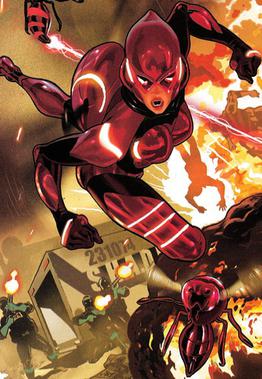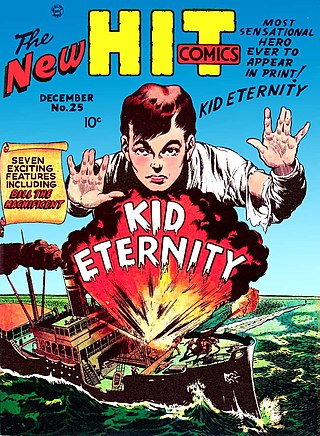Quality Comics
| Kid Eternity | |
|---|---|
 Hit Comics #25 (December 1942) | |
| Publication information | |
| Publisher | Quality Comics, later DC Comics/Vertigo |
| First appearance | Hit Comics #25 (December 1942), Quality Comics |
| Created by | Otto Binder (writer) Sheldon Moldoff (artist) |
| In-story information | |
| Alter ego | Christopher "Kit" Freeman |
| Supporting character of | Marvel Family |
| Abilities | Summoning of historical or mythological figures, intangibility |
Prior to issue #25, Hit Comics had a series of rotating cover features, including Hercules, the Red Bee, Stormy Foster and Neon the Unknown. However, December 1942 saw the entire line-up of comics at Quality change their features (if not always the cover feature). Kid Eternity was brought in from the start as the new cover feature for Hit. [2]
The character may have been based on the 1941 movie Here Comes Mr. Jordan, in which a prizefighter dies too soon in a plane crash and is given a new life by a celestial guide. [3]
He proved to be popular enough that when Quality Comics began expanding their post-war line, the Kid got his own self-titled comic book, Kid Eternity, in the spring of 1946. [4] Further illustrating the popularity of the character, his antagonists, Her Highness and Silk were given their own strip in Hit Comics #29 through #57.
By the late 1940s, however, Quality Comics was experiencing the post-war bust that most superhero comics were. In November 1949, Kid Eternity's self-titled magazine was discontinued (with issue #18) and his lead slot in Hit Comics was given over to Jeb Rivers, a riverboat captain (with issue #61).
Character origin and powers
The Kid was originally a nameless boy (who remembered being called only 'Kid' by his 'Gran'pa') who was killed when a U-boat sank his grandfather's fishing boat during World War II. Due to a supernatural mix-up, however, he was killed 75 years too soon (similar to the plot of the 1941 film Here Comes Mr. Jordan ).
To rectify the error, the Kid was brought back to life for another 75 years with the mission of upholding good in the world. [5] He was given the power to summon any good historical or mythological figure or animal by saying the word "Eternity" as well as to use the same word to make himself material or immaterial and invisible. Kid Eternity was further assisted on his duties by the clerk who'd made the error, Mr. Keeper. He is sometimes shown summoning fictional figures, like Jean Valjean or the Three Witches in Macbeth. In Kid Eternity #2 he shows time travel ability.
In the first few stories, Kid Eternity would take over the bodies of the historical characters he summoned, but starting from Hit Comics #28, the summoned characters were shown to exist separately from the Kid.
According to Jess Nevins' Encyclopedia of Golden Age Superheroes, "with the help of people like Sir Launcelot, Merlin and Hercules, [Kid Eternity] fights against crime, evil, the Germans, the super-strong Mr. Puny, Master Man (Satan's personal servant, who can summon history's greatest villains), and Dr. Pain, the master of agony". [6]
Villains
- Her Highness and Silk: An elderly woman (complete with glasses and white hair) and her young, attractive assistant. Thieves and confidence scammers, the characters were humorous in nature, almost never succeeding in their plans but always willing to try another "get rich quick" scheme. [7] Their first appearance was in Hit Comics #27 (April 1943). [8] They were quickly spun off into their own feature; in the next issue, Her Highness was on the cover, and their spin-off lasted until issue #57. [9] In 1982, she and Silk appeared in a Captain Marvel story guest-starring Kid Eternity (World's Finest #282).
- Master Man: Kid Eternity's opposite number, Master Man was given powers similar to the Kid's by the Devil. When Master Man said "Stygia", he could summon any evil historical or mythological figure from Stygia (first Appearance: Kid Eternity #15). When defeated he was taken back to Stygia by the ground opening beneath him, but returns later to gather more lost souls.
- Thuggoths: Evil creatures, part man, part beast, who were imprisoned in a pyramid 3000 years ago by the Egyptian pharaoh King Tut-ankh-amen, but escape and plan to take over the world, killing experts on Egyptology so it is not known how to kill them. Kid Eternity tracks them to the pyramid, is attacked by one but summons up William Tell who slays it with an arrow, and later summons up Tut, who finally destroys them with fire. He only appears in Kid Eternity #1.
- Dr. Marko: A world-renowned scientist who after being paid by foreign agents to set off radio controlled mines in a city harbour, thus killing hundreds of people, is sentenced to hanging. He decides to travel through time to attack America when it was smaller and weaker, and invents a time-globe to travel to the past, although he takes the Kid with him after they realise a mortal is meddling with Eternity, not realising who he is. Marko attempts to change history twice but is foiled. Mr. Keeper then take Marko back to the day of his execution, where he is hanged, and sends the globe far into the future, where men will learn to use its great powers. Dr. Marko appeared only in Kid Eternity #2.
- Mr. Keeper's evil brother: An evil twin brother of Mr. Keeper, who was banished to Stygia by Mr. Keeper using the Cup of Jove, for rewarding evil and punishing good, but escapes to get revenge and uses his powers to help criminals. He fights Mr. Keeper, distracting him and knocks him out, before binding him and impersonating him. He is banished once more with the Cup of Jove.
- Frank Malone: Leader of a group of kidnappers who kidnap a rich girl, called Kathryn, the Greenbriar heiress, and demand a $50,000 ransom. The Kid foils the Kidnappers, and saves the girl from a fire in the car, even though she was supposed to die that day.















